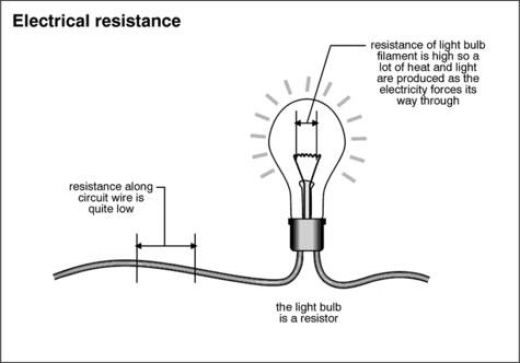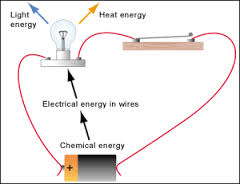
We often take for granted the ubiquity of electric lighting is these days. Just a few hundreds years ago we didn’t even know the basic principles behind electricity. All we could do is cower at lightning every once in a while, and if the stories are true then maybe you’d tie a key to a kite in a lightning storm to see what happens. And yet in other parts of the world (if you’re from the US/Canada), lights are a hot commodity. We know they run off of electricity, but one may be hard-pressed to really explain just how the things work. It’s actually much, much simpler than you thought (probably).
 There’s a fundamental concept of energy transformation in science that says any time you convert between types of energy, you lose some of it in the process. It’s like saying you can go to the casino and blow a thousand bucks on slots, and you might break even at the end of the day, but the time you spent pulling the lever is now lost. In terms of energy, we might say that if you drop a rock off a cliff, the energy it has when it gets near the bottom is mainly in the form of speed – you wouldn’t want to be standing under it, would you? It’s chock full of energy that was transformed from potential to kinetic (in this case, from its high position to its high speed during the fall).
There’s a fundamental concept of energy transformation in science that says any time you convert between types of energy, you lose some of it in the process. It’s like saying you can go to the casino and blow a thousand bucks on slots, and you might break even at the end of the day, but the time you spent pulling the lever is now lost. In terms of energy, we might say that if you drop a rock off a cliff, the energy it has when it gets near the bottom is mainly in the form of speed – you wouldn’t want to be standing under it, would you? It’s chock full of energy that was transformed from potential to kinetic (in this case, from its high position to its high speed during the fall).
In the same way, light bulbs and all concepts of electricity essentially incorporate this energy loss into their design. Commonly the energy that’s lost during a transformation is either heat or light, or both. Hm… can you think of any devices that put out heat and light? Hopefully there’s a light bulb over your head right now, because that’s exactly what we’re referring to here. The bulb on the left here is getting so hot that it’s producing light. Ever wonder why a stove’s coils burn red hot? That’s light being emitted along with heat.
The bulb itself is little more than a single piece of wire that’s conducting. We know intuitively that rubber doesn’t conduct electricity that well, but most metals do, so we use metallic wire here. You run your single wire from an initial power source and through the bulb, making sure that only a single path exists and that the wire never touches itself farther down. The wire comes out of the bulb and connects back to the power source, making a circle, or a circuit. If you’ve got a D battery at one end, you can hook your piece of wire to the two ends of the battery, run the body of the wire through a bulb, and produce some light from it!

The trick here is that inside the light bulb there is a section of tightly coiling wire. You can see it clearly in the picture above. As electricity flows through this section, it encounters resistance, just like you might if you were running down a straight hallway and suddenly had to turn multiple corners as fast as you possibly could. The electricity is forced to slow down here, and because all energy is conserved, the energy that was previously shooting down the wire is split off into an equal magnitude but different form of energy, namely, heat. As a result, the wire gets really, really hot. Rub your hands quickly together and the resistance between them causes heat to be generated, which we love to do in the winter when it’s freezing cold outside. It’s the exact same principle – friction between two objects “generates” heat energy. Also important here is that we can change the resistance to virtually any value we please, making it easier or more difficult for electricity to pass through or generate some heat.
 As the wire gets hotter and hotter, it eventually starts to put out light. This light energy is another manifestation of the wasted energy from this transformation process. But this is exactly the reason we use light bulbs in the first place! What we’ve essentially done is force energy into a conducting wire, force it into a bulb, and finally force it to splinter off into several kinds of energy that are observable in different ways. We can feel the heat from a light bulb, we can see the light it emits, and we can test the wire to see whether there’s still energy flowing through it.
As the wire gets hotter and hotter, it eventually starts to put out light. This light energy is another manifestation of the wasted energy from this transformation process. But this is exactly the reason we use light bulbs in the first place! What we’ve essentially done is force energy into a conducting wire, force it into a bulb, and finally force it to splinter off into several kinds of energy that are observable in different ways. We can feel the heat from a light bulb, we can see the light it emits, and we can test the wire to see whether there’s still energy flowing through it.
In essence, the resistance we give the light bulb at the coiled section expends the energy we’ve fed it, so the result is a great deal of heat and a great deal of light. The interesting part is that a light bulb is basically just the guts to any electric appliance, like a microwave or a refrigerator. If you had your wire connecting to a microwave instead of a light bulb, you’d get some power into it and you could make hot chocolate. Light bulbs by design don’t have any useful function except to release electrical energy – they can’t power a hair dryer by themselves. All the energy you’d spend charging your phone at night is instead released by a light bulb to provide a continuous stream of light. Here’s the kicker though: you might guess that only a small fraction of the total energy goes towards light and heat release. Unfortunately, if we take 100 units of some arbitrary energy and send it through a light bulb, only 3 of those units are really producing the light we need –all the other 97 units are wasted as heat, which is why leaving lights on in the summer makes a room really hot (or why a spotlight on a school’s auditorium stage makes you sweat!)
This huge waste of energy as heat that we don’t need is an ongoing problem as we try to develop better light bulbs. A big hurdle is that the light we need from light bulbs is really a result of the release of heat, so it’s hard to have one without the other.
When you think about it, the very purpose of a light bulb is to be wasteful. We want that electrical energy to be released, rather than contained in the conducting wire, because its release provides us with a huge amount of heat and a relatively small amount light. A light bulb’s energy disperses as heat and light much like any electrical device might, but in a much greater quantity than any hair dryer or electric razor. Most of the energy we put into those devices actually goes towards useful work (the hair dryer spitting out hot air, or the razor’s blades whirring). On the other hand, the light bulb is like an appliance without a function – energy runs through it, is entirely wasted, and just happens to produce some light as a by-product.
As for the eventual heat death of the universe due to the effects of entropy, well, that’s a discussion for another time.